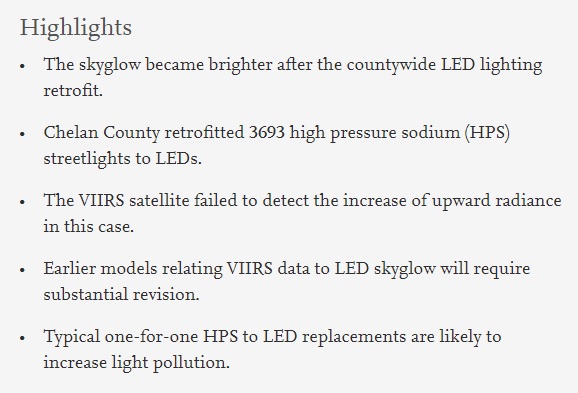Li-Wei Hung, Sharolyn J. Anderson, Ashley Pipkin, Kurt Fristrup, Changes in night sky brightness after a countywide LED retrofit, Journal of Environmental Management, Volume 292, 2021, 112776, ISSN 0301-4797,
https://doi.org/10.1016/j.jenvman.2021.112776.
(https://www.sciencedirect.com/science/article/pii/S0301479721008380)

Abstract
The US National Park Service (NPS) Night Skies Program measured changes in sky brightness resulting from a countywide lighting retrofit project. The retrofit took place in Chelan County, a gateway community to North Cascades National Park and Lake Chelan National Recreation Area in Washington State. The county retrofitted all 3693 county-owned high pressure sodium (HPS) street lamps to full cutoff LEDs. This number is about 60% of the County’s total outdoor street and area lights. About 80% of the newly installed lights were 3000 K in color temperature and 20% were 4000 K. The 4000 K LEDs were used to meet Washington State Department of Transportation guidelines. To measure sky brightness, we used the NPS night sky camera system before the retrofit started in 2018 and after its completion in 2019. These images were photometrically calibrated and mosaicked together to provide hemispherical images in V band. For comparison with our ground-based measurement, we obtained the satellite imagery taken by Visible Infrared Imaging Radiometer Suite (VIIRS) onboard the Suomi National Polar-orbiting Partnership satellite. Our measurements show that the post-retrofit skyglow became brighter and extended higher in the sky, but upward radiance, as measured by the day-night band radiometer, decreased. These divergent results are likely explained by a substantial increase in light emitted at wavelengths shorter than 500 nm, and a relative decrease in upward light emission due to better shielded luminaires. These results also demonstrate that earlier models relating VIIRS day-night band data to skyglow will – at a minimum – require substantial revision to account for the different characteristics of solid state luminaires.
Extract
The authors:
How do we convert to LED technology in a way that reduces energy consumption, reduces skyglow, preserves historical ambiance, and still meets the safety and security needs of our communities?
We believe with proper design and usage, energy savings and light pollution reductions can stand on the same side, both benefiting from LED retrofits. This study implies reductions in skyglow will require lowering overall light level (>50%), using warmer lights (< 3000 K), or both. Perceived conflicts between streetlighting objectives and light pollution can be further mitigated through controls that dim lights during periods of low traffic. More case studies are needed to pinpoint the exact criteria for a lighting retrofit to reduce skyglow. Nonetheless, a strong proactive lighting design is the key to converting to LED lights without increasing light pollution.
https://www.sciencedirect.com/science/article/pii/S0301479721008380
